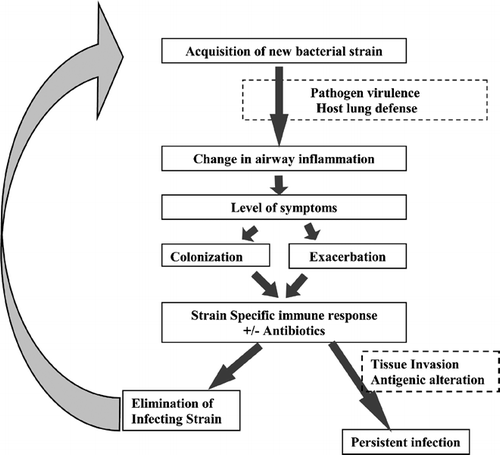Figures & data
Figure 2. Time lines and molecular typing for patients with COPD. The horizontal line is a time line, with each number indicating a clinic visit. The arrows indicate exacerbations. Isolates of H. influenzae and M. catarrhalis were assigned types based on sodium dodecyl sulfate-polyacrylamide gel and pulsed-field gel electrophoresis respectively. The types are indicated by letters A to E. Molecular mass standards are noted on the left of the gels. Reproduced with permission from Sethi et al. (Citation[20]).
![Figure 2. Time lines and molecular typing for patients with COPD. The horizontal line is a time line, with each number indicating a clinic visit. The arrows indicate exacerbations. Isolates of H. influenzae and M. catarrhalis were assigned types based on sodium dodecyl sulfate-polyacrylamide gel and pulsed-field gel electrophoresis respectively. The types are indicated by letters A to E. Molecular mass standards are noted on the left of the gels. Reproduced with permission from Sethi et al. (Citation[20]).](/cms/asset/17f4eb10-81de-4887-8968-79b9be74f50f/icop_a_165108_uf0002_b.gif)
Table 1. Isolation of a new strain of a bacterial pathogen and increases the risk of exacerbation of COPD
Figure 3. Comparison of H. influenzae exacerbation (Exac) and colonization (Col) strains. *denotes p < 0.05. Reproduced with permission from Chin et al. (Citation[22]). (A) Neutophils in bronchoalveolar lavage (BAL) in response to mouse airway infection with bacterial strains. (B) Adherence of bacterial strains to tracheobronchial epithelial cells in culture. (C) Production of interleukin-8 (IL-8) by tracheobronchial epithelial cells in culture on exposure to bacterial strains.
![Figure 3. Comparison of H. influenzae exacerbation (Exac) and colonization (Col) strains. *denotes p < 0.05. Reproduced with permission from Chin et al. (Citation[22]). (A) Neutophils in bronchoalveolar lavage (BAL) in response to mouse airway infection with bacterial strains. (B) Adherence of bacterial strains to tracheobronchial epithelial cells in culture. (C) Production of interleukin-8 (IL-8) by tracheobronchial epithelial cells in culture on exposure to bacterial strains.](/cms/asset/240c9541-4b07-4508-bd1c-62fef733fb62/icop_a_165108_uf0003_b.gif)
Figure 4. Comparison of serum IgG and sputum IgA antibody response to homologous strains of M. catarrhalis following colonization or exacerbation. Based on data from Murphy et al. (Citation[25]). (A) Percent of episodes of colonization or exacerbation that were associated with an antibody response. (B) Intensity of antibody response as a percent change from baseline level of antibody. Median values are shown.
![Figure 4. Comparison of serum IgG and sputum IgA antibody response to homologous strains of M. catarrhalis following colonization or exacerbation. Based on data from Murphy et al. (Citation[25]). (A) Percent of episodes of colonization or exacerbation that were associated with an antibody response. (B) Intensity of antibody response as a percent change from baseline level of antibody. Median values are shown.](/cms/asset/a72eb78d-7d8b-4fcb-8c03-3110568e9f41/icop_a_165108_uf0004_b.gif)
